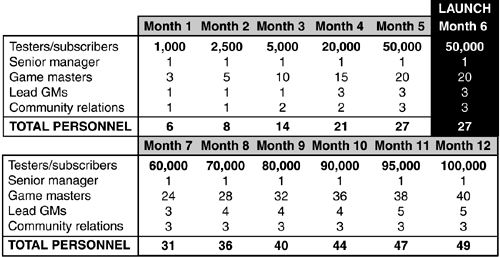Ramping Up Player Support
Ramping Up Player SupportOne of the industry's consistent mistakes is to underestimate the extent of player support needed for a PW. As discussed elsewhere in this book, the total number to bring on-board depends on whether the proper support tools exist and whether the game is stable. The questions of "How many?" and "When?" support personnel need to be hired , trained, and deployed are at the center of vigorous debate within the industry, with proponents of different solutions displaying zeal and intensity more typically associated with religious belief. Ask any professional in the industry and you'll probably get a different answer each time. What we end up with, then, are cases that contrast wildly, such as UO versus EQ , where EQ has two-and-a-half to three times as many support personnel as UO to handle about twice the number of subscribers, or Asheron's Call ( AC ) , which has less than 20% of the support personnel as UO to handle about one-third of the subscriber base. Everybody does it differently; the only consistent element to support is that players in almost every game agree that it is done badly , inconsistently, and it takes too long to get help. When to bring on support personnel and in what numbers have no standard answers, either. To control costs, most companies try to ramp up support in the 30 days before launch. While fiscally reasonable, this ignores that PWs are complicated beasts with unique idiosyncrasies that take a great amount of playing time to truly understand. In most cases, it is virtually impossible to train gamemasters (GMs) to provide adequate support in 30 days or less; you need more like 60 “90 days. While you'll have one or two people assigned to support the game during Alpha, probably from QA, the time to start seriously hiring and training your support staff is during the six-month Beta phase. At that point, the game should be feature-complete; no new systems or mechanics will be added that will require trainees to have to hurry to keep up with the players. The model to use is the same one General Von Steuben used to train the Continental Army during the Revolutionary War: Start small, train a select group , and use them to train more people later on. Using the Von Steuben method, Table 9.2 shows how such a ramp-up can occur. The idea is to add people as you increase the number of testers, until you have enough trained GMs at launch to adequately support the expected load. Estimating how many subscribers you'll have at launch is still something of a black art, but you should be able to make a reasonable estimate based on how many testers you have, how many Beta test applications you've received, and how well the buzz has created pre-orders for the retail unit (if there will be one). The example in 9.2 is based on a game launching after reaching 50,000 testers at the end of Beta and reaching 100,000 subscribers within six months of launch. Table 9.2. Player Support Ramp-UpAn example of ramping up player and community relations during the Beta phase to achieve 1 GM per 2,500 subscribers at launch, plus leads and managers. Based on our experience with many online games over the past 16 years , and assuming all the requisite tools are in place and functioning and that you intend to provide 24/7 service, the best recommendation we can make is to have a minimum basic ratio of one frontline GM for every 2,500 total subscribers you expect at launch and be ready to add personnel quickly if the game sells like hotcakes. You should reach this number at least one month before launch, to give most of your support personnel time to become familiar with the game. The costs of hiring and training shouldn't be your only consideration here; you also have to consider the intangibles, such as how speed of response enhances your reputation for good CS and acts as an acquisition tool, to bring in more subscribers through good word of mouth. With a smooth launch being such an important factor in the acquisition of subscribers, a smart company that expects a game to do well right out the gate (and can afford the wage, salary, and benefits load) should take the GM totals in Table 9.2 and increase them by 50% to ensure better response times to player help requests , both in-game and via email. It will be a balancing act between your need to have an adequate staff and the size of your launch budget. The best advice we can give is not to treat this area as disposable; good customer support is the main differentiator between PWs today. Having good support through a trained and adequately sized team is both an acquisition and retention tool; poor or sloppy support costs you subscribers in the long run. |
EAN: 2147483647
Pages: 230
